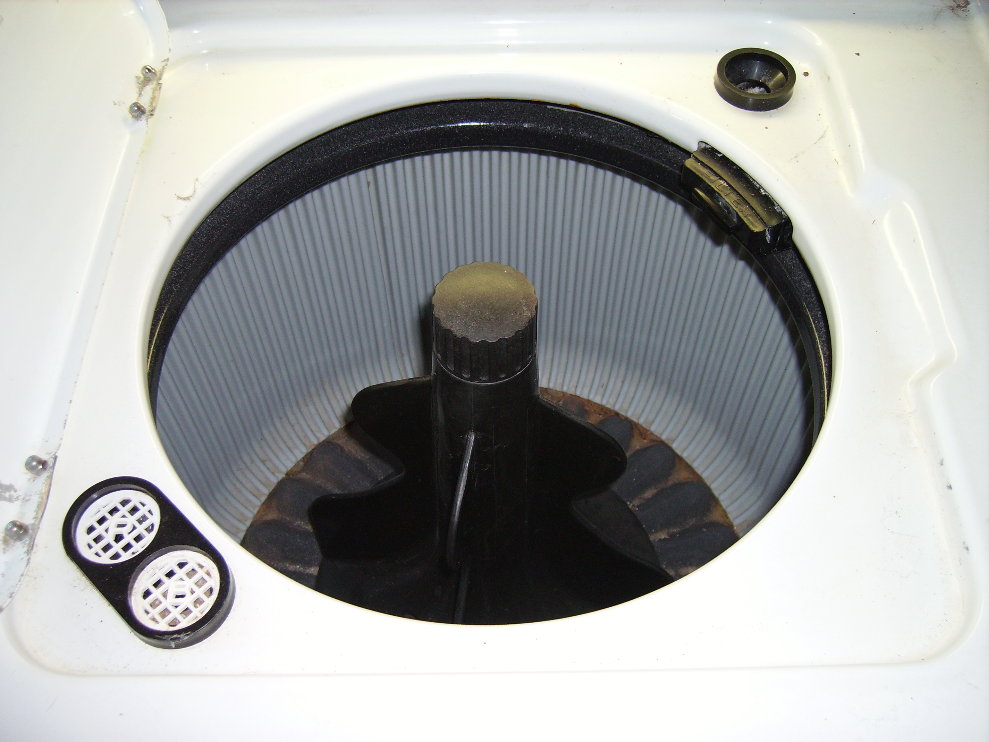|
Thread Number: 48992
Solid Tub Designs |
[Down to Last] |

|
Post# 709593 , Reply# 2 10/16/2013 at 06:23 (3,844 days old) by DADoES  (TX, U.S. of A.) (TX, U.S. of A.) |
||
It always mystified me as to how solid tub machines could even drain growing up. I know that the drain is under the agitator, ...The only solid-tub machine that had the primary drain under the agitator, far as I'm aware, is the Blackstone. The tub literally lifted upwards slightly to open the outlet for a neutral drain period, then water extracted from the clothes during spin exited over the top of the tub as per the usual. Some solid-tub designs had a heavy-soil ejector, a pipe mounted to the hub of the tub which curved up around the bowl above the water level. It operated on the theory that sand and dirt would collect in the hub under the agitator and then flow out of the pipe with a bit of the water via centrifugal force during spin. My understanding that is it often clogged over time and ended up ineffective. | ||
Post# 709599 , Reply# 3 10/16/2013 at 06:48 (3,844 days old) by turquoisedude  (.) (.) |
||
 | ||
Post# 709607 , Reply# 4 10/16/2013 at 07:48 (3,844 days old) by bajaespuma  (Connecticut) (Connecticut) |
||
 | ||
| Post# 709615 , Reply# 5 10/16/2013 at 08:20 (3,844 days old) by Blackstone (Springfield, Massachusetts) | ||
Blackstone 350 tub | ||
| Post# 709616 , Reply# 6 10/16/2013 at 08:21 (3,844 days old) by Blackstone (Springfield, Massachusetts) | ||
Blackstone 350 tub | ||
Post# 709626 , Reply# 7 10/16/2013 at 09:09 (3,844 days old) by Yogitunes  (New Jersey) (New Jersey) |
||

didn't GE solid tubs have a port under the agitator to let water, as well as sand escape to the outer tub?....
my solidtub Speed Queens sediment ejectors are both sealed shut, and yet never have an issue with sand building up under the agitator....I pull the agitator on ocassion just to check and clean if needed.... | ||
Post# 709630 , Reply# 8 10/16/2013 at 09:32 (3,844 days old) by Unimatic1140  (Minneapolis) (Minneapolis) |
||

I know that the drain is under the agitator, but when the tub spins, isn't it angled so that the water flows up and over the rim of the tub when it spins?
No with the exception of the Blackstone, solid tub washers spin the water over the top of the tub via centrifugal force, there is no drain at the bottom, it is completely sealed. Solid tubs were abandoned mainly because they do not accommodate large capacity designs very well and the design has trouble removing sand. But solid tub washers do have a major advantage as they rinse better than any other washer design as well as handle suds removal better than any other washer design ever created as of yet. They rinse better because once dirty/soil laden water and suds are thrown into the outer tub there is not way for any residual water or suds to come in contact with the clothes again during the rinse cycle. I mainly use solid tub washers, I find their performance is best for rinsing. We do not have a problem with sand removal as we are two grown adults and have very little reason to have much sand in our wash loads. | ||
Post# 709697 , Reply# 9 10/16/2013 at 16:31 (3,844 days old) by mayfan69  (Brisbane Queensland Australia) (Brisbane Queensland Australia) |
||
Solid tub machines in Australia
Simpson sold their solid tub 'Fluid Drive' models from 1958 to about 1975, when they were phased out in favour of a larger capacity perforated tub design.
The only reason they were phased out was just as Robert described was due to its smaller capacity but also the fact that Simpson fluid drives didn't have tub brakes and new laws around this time stated all machines on the Australian market had to brake within 12 seconds when the lid was opened. To achieve a cleaner wash with the solid bowl design, Simpson introduced the 'flexible channel tub' (the plastic liner) in 1966. The idea being that heavier soil would drain 'behind' the plastic liner during spin. I always thought this was marketing hype until i took apart a plastic liner to clean and saw the dirt attached to the outside of the liner. If you watch my video, you should see the water drain 'down' and then out behind the liner. I think i have a video of the machine draining without clothes in it, but have to upload it. Cheers Leon CLICK HERE TO GO TO mayfan69's LINK 
| ||

 Comes to the Rescue!
Comes to the Rescue!